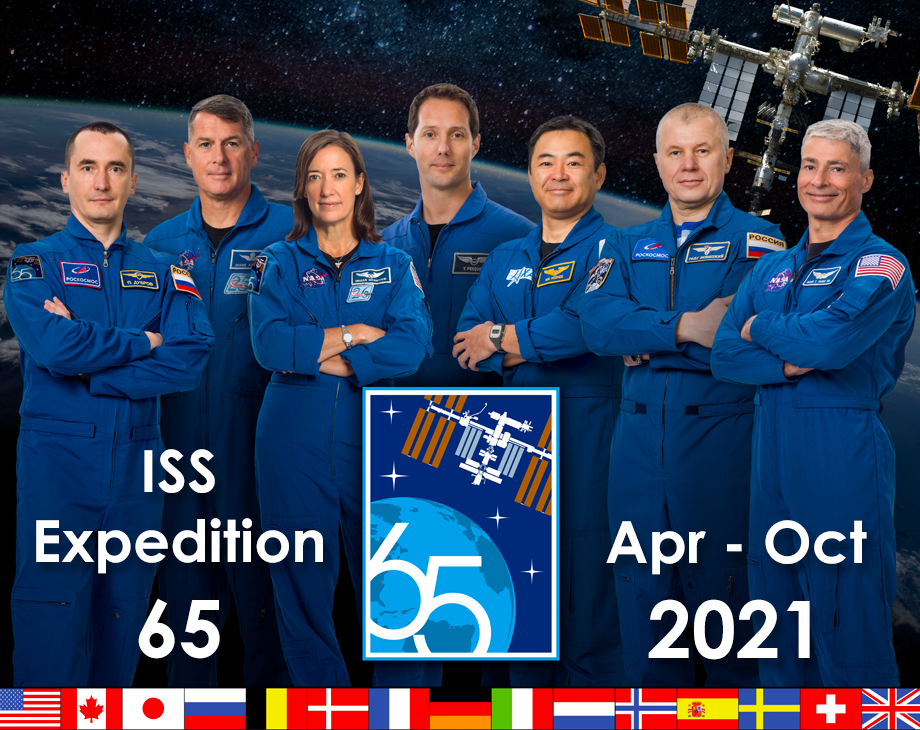 Title: ISS Expedition 65: Oleg Novitsky, Shane Kimbrough, Megan McArthur, Thomas Pesquet, Akihiko Hoshide, Oleg Novitsky and Mark Vande Hei. NASA, April 2021.
Title: ISS Expedition 65: Oleg Novitsky, Shane Kimbrough, Megan McArthur, Thomas Pesquet, Akihiko Hoshide, Oleg Novitsky and Mark Vande Hei. NASA, April 2021.
ISS Expedition 65, 17 April to 04 October 2021
Expedition 65 was a long duration expedition that included three crews arriving at the International Space Station (ISS) in consecutive flights. The expedition ended with the docking of the Soyuz MS-19 on 05 October 2021.
Astronaut roles changed as the crews were replaced during the expedition:
| Position | 17 April – 24 April 2021 | 24 April – 2 May 2021 | 2 May – 4 October 2021 |
|---|---|---|---|
| Commander | Second spaceflight |
Third spaceflight |
|
| Flight Engineer 1 | Second spaceflight |
Third spaceflight |
|
| Flight Engineer 2 | First spaceflight |
Second spaceflight |
|
| Flight Engineer 3 | Third spaceflight |
Second spaceflight |
|
| Flight Engineer 4 | Third spaceflight |
||
| Flight Engineer 5 | First spaceflight |
||
| Flight Engineer 6 | Second spaceflight |
||
| Flight Engineer 7 | Third spaceflight |
||
| Flight Engineer 8 | Second spaceflight |
||
| Flight Engineer 9 | Third spaceflight |
||
| Flight Engineer 10 | Second spaceflight |
||
Updates on Expedition 65
15 November 2021 – Crew-2 Post Mission News Conference
NASA’s Expedition 65 ended with a successful landing on 08 November 2021. The members of Crew-2 were joined again on 15 November for a news conference.
Members of the public and journalists had the chance to ask questions about the six months spent at the ISS. As they re-adapt to Earth’s gravity, they are still in a process of debriefing and following medical checks before they taka a well-deserved break from work.
The crew highlighted that their time at the ISS is a form of public service that benefits everyone by advancing the frontiers of science and strengthening the collaboration between nations. They talked about the process of maintaining the spacecraft to continue working beyond her 20 years to gain more knowledge and experience for future missions to the Moon and Mars.
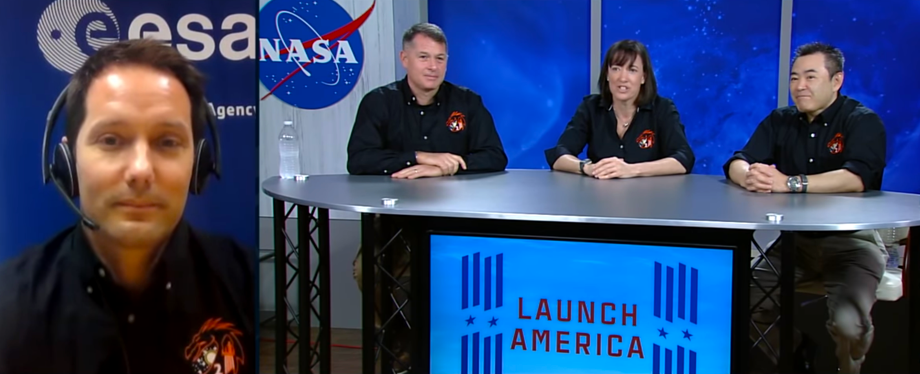 NASA’s Crew-2 Post-Mission news conference. Thomas Pasquet, Shane Kimbrough, Megan McArthur and Akihiko Hoshide. NASA/ESA/JAXA, 15 November 2021.
NASA’s Crew-2 Post-Mission news conference. Thomas Pasquet, Shane Kimbrough, Megan McArthur and Akihiko Hoshide. NASA/ESA/JAXA, 15 November 2021.
Watch the full post-mission news conference (36 min):
08 November 2021 – Crew-2 returns to Earth
On Monday 08 November 2021, NASA’s SpaceX Crew-2 returned to Earth onboard the Dragon Endeavour spacecraft after 199 days of work at the International Space Station.
Crew update
The members of Crew-2 were all seasoned astronauts selected by their agencies for their ability to carry out the mission objectives at the ISS. After the mission, their time in space increased as follows:
| Astronaut | Role | Total days in space |
|---|---|---|
| Shane Kimbrough | Commander | 388 |
| Megan McArthur | Pilot | 208 |
| Akihiko Hoshide | Mission specialist Commanded ISS |
340 Second highest of any JAXA astronaut |
| Thomas Pasquet | Mission specialist Commanded ISS |
395 Most of any ESA astronaut |
Moving away from ISS
The process of separation from the ISS involves 5 burns. The returning capsule first flies around the ISS for a visual inspection of the station and then moves away towards Earth to an altitude of 10km before committing to the last burn. If the weather on Earth is not favourable, the crew could remain in orbit for up to 2 days, otherwise, they would proceed to the last 16.5 min Deorbit Burn. This is the most important action to penetrate the atmosphere and aim for their target on the surface of our planet.
 Diagram of Dragon Endeavor spacecraft separation from ISS. Fly around burns. NASA, 08 Nov 2021.
Diagram of Dragon Endeavor spacecraft separation from ISS. Fly around burns. NASA, 08 Nov 2021.
 Diagram of Dragon Endeavor final burns to enter the atmosphere. NASA, 08 Nov 2021.
Diagram of Dragon Endeavor final burns to enter the atmosphere. NASA, 08 Nov 2021.
The maximum return speed of 28,000 kph (required by a vehicle to remain in orbit) is reached shortly before re-entry. Once the capsule enters the atmosphere, it slows down rapidly as it collides with increasing amounts of particles in the atmosphere. The friction between air particles and the heatshield generates plasma at temperatures above 1,900 Centigrade.
The capsule slows down to 560 kph in nearly 7 minutes resulting in a decelerating force of 3.5 to 4 G. The astronauts feel their body weight increase by that amount for a few minutes as they rest on their seats in a semi-inclined position. When the capsule crosses the speed of sound at 1,200 kph, there is a sonic boom audible from the ground.
Because the arrival of Dragon Endeavour took place at night, monitoring of the flight required thermal imagery. NASA’s WB-57 high altitude research aircraft, a converted bomber, provided the first thermal images of the capsule as it glowed against the dark sky, encased in hot plasma during re-entry, shortly before the emergence from communications blackout.
 Thermal image from NASA’s W57 aircraft showing Dragon Endeavour’s plasma generated glow as the vehicle enters the atmosphere. NASA, 08 November 2021.
Thermal image from NASA’s W57 aircraft showing Dragon Endeavour’s plasma generated glow as the vehicle enters the atmosphere. NASA, 08 November 2021.
At 5 km altitude, the 2 drogue parachutes are automatically deployed, followed by the 4 main parachutes. On this occasion, one of the main parachutes had a delayed inflation due to the straps getting entangled in the turbulence.
 Sequential thermal image of 2 drogue parachutes first, followed by 4 main parachutes deployed to slow down the descent of the Dragon Capsule. NASA, 08 November 2021.
Sequential thermal image of 2 drogue parachutes first, followed by 4 main parachutes deployed to slow down the descent of the Dragon Capsule. NASA, 08 November 2021.
Splash down
Three minutes later, at 03:33 BST on 09 Nov (22.33 EST on 08 Nov), the Dragon Endeavour capsule, carrying NASA’s SpaceX Crew-2 splashed down on the Gulf of Mexico near Pensacola, Florida, USA.
 Thermal image of Dragon Endeavour splash down in the Gulf of Mexico, close to Pensacola, Florida, USA. NASA, 08 November 2021.
Thermal image of Dragon Endeavour splash down in the Gulf of Mexico, close to Pensacola, Florida, USA. NASA, 08 November 2021.
Splash down location
In preparation for splash down, the ground team selects 7 sites based on weather patterns and status of the sea in the Gulf. The potential zones are in the Gulf of Mexico, near Pensacola or Tallahassee, Florida, USA.
Waiting for the Dragon in the Gulf Coast are fast boats, which are the first to approach the capsule. The recovery vessel called Go Navigator is nearby and will recover the Dragon Capsule and place it onboard onto the Dragon’s Nest before the crew exits the capsule. This vessel has a helipad and a helicopter on stand-by to take the astronauts to land.
Should they splash down in a different location, the ground crew can request assistance from the Navy.
Recovery
Recovery team boats congregate near the capsule as it floats in the ocean. In the first 30 minutes after splashdown, the fast boats recover the parachutes, inspect the spacecraft and approach it to request permission to board to connect the hoists that will help lift the Dragon onto the main recovery vessel.
 Thermal image of Dragon Endeavour surrounded by fast boats recovering parachutes and preparing the spacecraft for recovery. NASA, 08 November 2021.
Thermal image of Dragon Endeavour surrounded by fast boats recovering parachutes and preparing the spacecraft for recovery. NASA, 08 November 2021.
Forty minutes after splashdown the capsule is lifted into the Go Navigator and secured to the Dragon’s Nest. The capsule is moved to a platform and specialists open the hatch and welcome the astronauts, who wait in their seats. The medical personnel of each agency check their health status of the astronauts before they are helped to egress the capsule under their supervision. Once they acclimatise and complete their health checks, they are air-lifted to their bases.
 Dragon Endeavour lifted onto the Go Navigator vessel to be placed on its base known as the Dragon’s Nest (seen at the bottom). NASA, 08 November 2021.
Dragon Endeavour lifted onto the Go Navigator vessel to be placed on its base known as the Dragon’s Nest (seen at the bottom). NASA, 08 November 2021.
 Opening Dragon Endeavour’s hatch: View from the platform outside (left) and from inside the capsule (right). NASA, 08 November 2021.
Opening Dragon Endeavour’s hatch: View from the platform outside (left) and from inside the capsule (right). NASA, 08 November 2021.
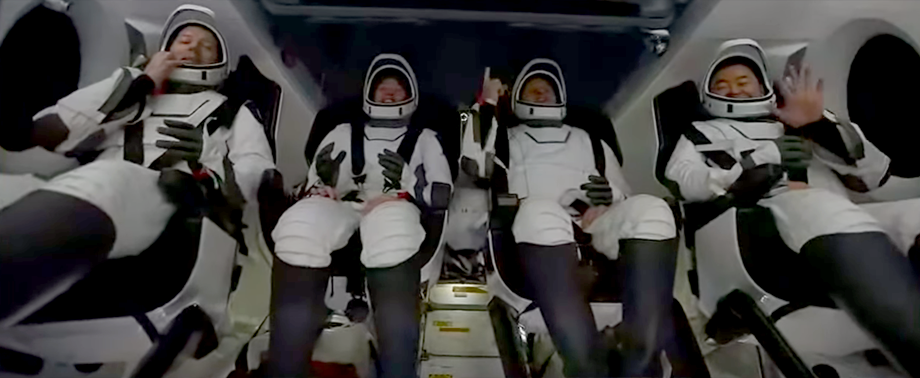 First view of SpaceX Crew-2 on their seats after returning from ISS.
First view of SpaceX Crew-2 on their seats after returning from ISS.Left to right: Thomas Pasquet, Megan McArthur, Shane Kimbrough and Akihiko Hoshide. NASA, 08 November 2021.
 Crew-2 outside the Dragon capsule, on stretchers as a medical precaution.
Crew-2 outside the Dragon capsule, on stretchers as a medical precaution.Left to right: Thomas Pasquet, Megan McArthur, Shane Kimbrough and Akihiko Hoshide. NASA, 08 November 2021.
After the recovery of the Dragon capsule, agency leaders recognised the virtues of working together in an international project like the ISS and the strengthening of the collaboration that will be needed for the future exploration of the Moon and Mars:
- For NASA: Kathy Lueders - Associate Administrator for Space Operations.
- For JAXA: Hiroshi Sasaki – Vice President and Director General for Human Spaceflight Technology Directory.
Live Broadcast
Live broadcast of the event was presented by Kate Tice, SpaceX senior certification engineer and Gary Jordan, representing the NASA communications team.
 Live Broadcast hosted by Kate Tice from SpaceX and Gary Jordan from NASA. NASA, 08 November 2021.
Live Broadcast hosted by Kate Tice from SpaceX and Gary Jordan from NASA. NASA, 08 November 2021.
Live broadcast of the event was presented by Kate Tice, SpaceX senior certification engineer and Gary Jordan, representing the NASA communications team.
Guin-Guin, the mascot and zero-G indicator, also returned to Earth onboard Dragon Endeavour.
 Guin-Guin boarding Dragon Endeavor at ISS (helped by Akihiko Hoshide). NASA, 08 November 2021.
Guin-Guin boarding Dragon Endeavor at ISS (helped by Akihiko Hoshide). NASA, 08 November 2021.
05 October 2021 – Russian civilians join Expedition 65
On Tuesday 05 October 2021, Russian actress Yulia Peresild, Russian film director Klim Shipenko and veteran Russian cosmonaut Anton Shkaplerov of Roscosmos launched on board the Soyuz MS-19 spacecraft from the Baikonur Cosmodrome in Kazakhstan; they will join Expedition 65 at ISS.
They will return to Earth on 17th October with Flight Engineer Oleg Novitskiy while Shkaplerov remains on ISS until March 2022.
 Actress Yulia Peresild, cosmonaut Anton Shkaplerov and film director Klim Shipenko launch on board a Soyuz MS-19 rocket to join Expedition 65 at ISS. NASA, 05 October 2021.
Actress Yulia Peresild, cosmonaut Anton Shkaplerov and film director Klim Shipenko launch on board a Soyuz MS-19 rocket to join Expedition 65 at ISS. NASA, 05 October 2021.
Peresild and Shipenko became participants rather than members of expedition 65. They underwent training at Gagarin Cosmonaut Training Centre since 24th May and in late July the movie company filmed a simulation inside a Soyuz replica while wearing Sokol suits (Soviet/Russian space suits).

During ascent, the crew brought two zero-G indicators and mascots: A toy cheetah given to Anton Shkaplerov by his daughter and a toy baby bird, brought by Yulia Peresild, a symbol of the charity "Galchonok", of which she is a founding member and aims at providing treatment for children with organic central nervous system disorders.
Russian movie in space
While on board, the two civilians will be filming scenes for a movie entitled “The Challenge” or “Challenge” (Russian:Vyzov or Вызов), in which Anton Shkaplerov appears as the pilot. Peresild plays the role of heart-surgeon Zhenya, who flies to space to perform a life-saving surgery in zero-gravity on cosmonaut Ivanov (played by Oleg Novitskiy), who loses consciousness while the spacecraft is in flight.
The filming equipment was launched on board Progress MS-17, a resupply spacecraft that reached ISS on 02 July 2021.
The mission logo created for the movie depicts a film strip at the base of a Soyuz rocket.
 Mission logo created for the Russian movie “The Challenge”. Wikipedia, 2021.
Mission logo created for the Russian movie “The Challenge”. Wikipedia, 2021.
Yulia Peresild is known for her acclaimed role as Soviet sniper Lyudmila Pavrichenko in the 2015 war movie Battle for Sevastopol, directed by Sergey Mokritskiy.
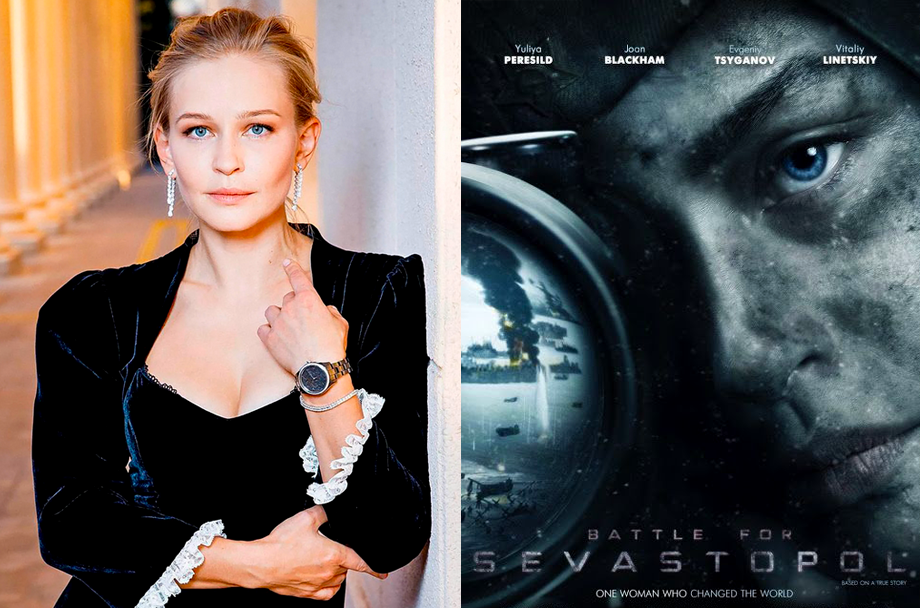 Russian actress Yulia Peresild played heroine Soviet sniper Lyudmila Pavrichenko in the 2015 war movie Battle for Sevastopol. Screendaily.com, 2015.
Russian actress Yulia Peresild played heroine Soviet sniper Lyudmila Pavrichenko in the 2015 war movie Battle for Sevastopol. Screendaily.com, 2015.
Before launch, the crew suited-up and had a last contact with their families and friends. They were accompanied by the backup crew: Oleg Artemyev, Aleksey Dudin and Alyona Mordovina.
 Yulia Peresild suited up before launch accompanied by back-up crew member Alyona Mordovina. NASA, 05 October 2021.
Yulia Peresild suited up before launch accompanied by back-up crew member Alyona Mordovina. NASA, 05 October 2021.
The selection of actors for the movie began in November 2020 and the finalists went trough fitness and medical testing at the Yuri Gagarin Cosmonaut Training Centre (GCTC) in March. The first finalist to play the lead female role was Alyona Mordovina. The movie casting process completed by producer and director Klim Shipenko on 13 May 2021 favoured Peresild as lead female, while Mordovina joined the back-up crew. Peresild became the fifth Soviet/Russian woman to be launched into Space.
Launch of Soyuz MS 19
The launch of the Soyuz MS 19 on 05 October 2021 went flawlessly with separation of the 3 stages and deployment of solar arrays as expected, followed by an orbital journey to catch up with the station.
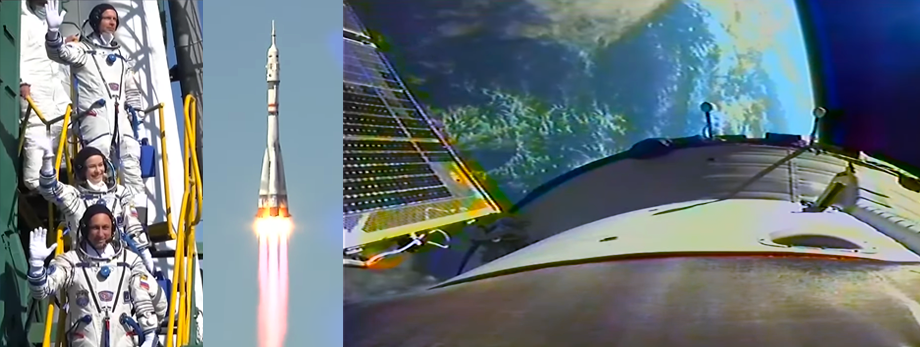 The Soyuz MS 19 rocket ascending from Baikonur Cosmodrome (left). A few minutes later the 4th stage of the spacecraft was in orbit around the Earth (right). NASA, 05 October 2021.
The Soyuz MS 19 rocket ascending from Baikonur Cosmodrome (left). A few minutes later the 4th stage of the spacecraft was in orbit around the Earth (right). NASA, 05 October 2021.
The Soyuz capsule docked to the Russian segment of the International Space Station, located on the Earth side of the spacecraft.
Once the pressure inside the capsule was equalised to that of the ISS, the Russian segment hatch was opened, followed by the Soyuz hatch at 16:00 hr GMT on 05 October 2021. First in was Soyuz Commander Anton Shkaplerov, followed by Yulia Peresild and Klim Shipenko.
 Soyuz Commander Anton Shkaplerov, followed by Yulia Peresild and Klim Shipenko ingress into the Russian segment of ISS (composite image). NASA, 05 October 2021.
Soyuz Commander Anton Shkaplerov, followed by Yulia Peresild and Klim Shipenko ingress into the Russian segment of ISS (composite image). NASA, 05 October 2021.
Shortly after their arrival the new crew met the members of Expedition 65, making a total of 11 astronauts of four nationalities on board the International Space Station. They received congratulatory calls from officials and dignitaries at the Russian Control Centre in Korolev, outside Moscow.
 ISS crew of 10: Top: Shane Kimbrough, Oleg Novitsky, Commander Thomas Pasquet, Megan McArthur, Pyotr Dubrov, Marke Vande Hie and Akihiko Hoshide.
ISS crew of 10: Top: Shane Kimbrough, Oleg Novitsky, Commander Thomas Pasquet, Megan McArthur, Pyotr Dubrov, Marke Vande Hie and Akihiko Hoshide.Bottom: Yulia Peresild, Anton Shkaplerov and Klim Shipenko. NASA, 05 October 2021.
Watch Soyuz MS 19 hatch opening and Crew Welcome Ceremony at ISS on 05 October 2021 below (1hr, 50min).
04 October 2021 – Change of Command of ISS
On Monday 04 October 2021, the Change of Command ceremony took place at ISS. In the event, exiting Commander Akihiko Hoshide passed his post and the keys to the International Space Station to the new Commander Thomas Pasquet. He is the first ESA and French Commander at ISS and recognised the active participation of France and Europe in the space programme.
 Change of Command Ceremony at ISS: Akihiko Hoshide hands the keys to ISS to the new Commander Thomas Pasquet. NASA, 04 October 2021.
Change of Command Ceremony at ISS: Akihiko Hoshide hands the keys to ISS to the new Commander Thomas Pasquet. NASA, 04 October 2021.
 Expedition 65, all hands on deck! NASA, 04 October 2021.
Expedition 65, all hands on deck! NASA, 04 October 2021.
Watch the ISS Change of Command Ceremony below.
12 September 2021 – Spacewalk 77
On 12 September 2021 two astronauts from Expedition 65, Thomas Pasquet (European Space Agency - ESA) and Akihiko Hoshide (Japan Aerospace Exploration Agency - JAXA) performed an extra vehicular activity (EVA) catalogued as U.S. Spacewalk 77. This EVA was Hoshide’s 4th spacewalk of his career and Pasquet’s 6th. Both astronauts arrived in April as part of Space-X’s Crew-2 mission to ISS.
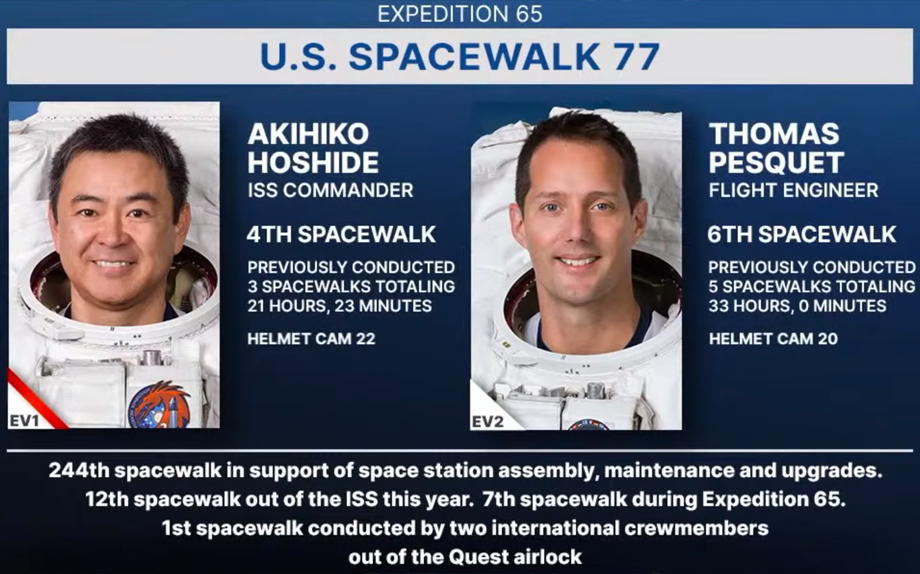 ISS Commander Akihiko Hoshide and Flight Engineer Thomas Pesquet perform US Spacewalk 77 on 12 September 2021. NASA/JPL, 2021.
ISS Commander Akihiko Hoshide and Flight Engineer Thomas Pesquet perform US Spacewalk 77 on 12 September 2021. NASA/JPL, 2021.
After putting on their space suits, assisted by their crew members, the spacewalkers entered the crew airlock, a pressure chamber adjacent to the egress hatch, to begin preparations for their EVA. First, they breathed pure Oxygen to purge Nitrogen from their bodies and avoid bubble formation in their bloodstream during decompression and recompression.
In the following step, the airlock pressure was reduced from the ISS’ normal pressure of 14.7 pounds per square inch (psi), equal to Sea Level on Earth, to zero, equal to the vacuum of space. Decompression stopped momentarily at 5 psi for final suit and instrument checks before switching their suits to battery power and formally beginning their EVA. Attached to their spacesuits the astronauts carry a “Safer” unit or “Space Jetpack” used to control motility in space in the unlikely event of becoming untethered.
During the spacewalk, they built and installed a mounting bracket on the 4A Power Channel (P4) in preparation for the next delivery of the new ISS Roll-Out Solar Array (iROSA). They also replaced the Floating Potential Measurement Unit (FPMU) to continue its usable life.
iROSA
The iROSA is a new supplementary set of solar panels that will be placed partly covering 6 of the 8 existing panels, which have been in service for more than 20 years, 5 years more to what they were designed for. The new panels developed by Boeing are smaller and more efficient and will provide up to 30% more power required by the increasing number of segments and experiments at the station.
The existing 8 solar arrays generate up to 160 kilowatts of power during daytime. When the new arrays are installed, this value will increase to 215 kilowatts. For comparison, a computer and monitor may use up to 270 watts, and a small refrigerator, about 725 watts, which means that with the upgrade, there will be enough power to run more than 290 refrigerators.
 New solar panel arrays iROSA (coloured in green) in their planned final position will increase the power generated by 30%. NASA, 2021.
New solar panel arrays iROSA (coloured in green) in their planned final position will increase the power generated by 30%. NASA, 2021.
The following 3D representation shows the installed mounting bracket close to the older solar arrays.
 3D representation of the installed mounting bracket for iROSA. NASA, 12 September 2021.
3D representation of the installed mounting bracket for iROSA. NASA, 12 September 2021.
A failed FPMU was replaced as shown below comparing the 3D representation and actual image during Spacewalk 77.
 Installation of the Floating Potential Measurement Unit (FPMU). 3D representation (left) and real footage during Spacewalk 77 (right). NASA, 12 September 2021.
Installation of the Floating Potential Measurement Unit (FPMU). 3D representation (left) and real footage during Spacewalk 77 (right). NASA, 12 September 2021.
Spacewalk 77 is the station’s 244th spacewalk in support of assembly, maintenance, and upgrades. The full event including preparations and the 6hr 54min spacewalk was broadcast live by NASA on 12 September 2021, and can be viewed below (video: 8hr, 44min).
02 July 2021 – Update on EVAs and more
Two days before USA’s day of independence celebrations (04 July), astronauts Shane Kimbrough and Thomas Pasquet were interviewed by ABC News and CBS News, and commented on their recent spacewalks to install the first solar arrays at the station. They gave their views on the upcoming commercial flights to low orbit by Virgin Galactic and Blue Origin, and commercial crews visiting ISS, and mentioned that there is a lot to gain from society’s investment in space and that they welcomed new opportunities to allow the public to see and experience living at ISS. They had no concerns about safety as all crews undergo training at the various space agencies around the world.
The astronauts discussed the plans to go to the Moon on a more permanent basis as part of the space exploration process, leading the way that will be followed by private enterprises.
Watch both interviews on the event of 02 July 2021 below (22min).
01 July 2021 – Updates and Guin-Guin
In an interview with Good Day L. A., astronauts Megan McArthur and Thomas Pasquet discuss their activities at ISS and comment on Guin Guin and the tradition of zero-G indicators.
Watch the second part of the interview with Good Morning Los Angeles (starting at 11min of the full 18min event).
BACKGROUND
SpaceX Crew-2
 Title: The journey of SpaceX Crew-2 to the International Space Station. Launched on 23rd and arrived on 24th April 2021.
Title: The journey of SpaceX Crew-2 to the International Space Station. Launched on 23rd and arrived on 24th April 2021.
Journey to the International Space Station
Pre-flight news
NASA’s pre-launch conference on 20 April 2021, provided an update on SpaceX Crew-2 mission and their preparations to launch the 3rd NASA’s Commercial Crew Programme flight with crew to the International Space Station (ISS). The programme is based on sub-contracting private companies, like SpaceX, to take astronauts to ISS.
Days prior to launch, the team conducted a series of tests including the firing of the 9 Merlin engines of the first stage of the rocket. The crew rehearsed suiting-up, approaching to the launch pad and entering and securing the vehicle.
Weather conditions at Kennedy Space Centre in Florida were better on Friday 23 April than the day before, when launch was initially scheduled. Maximum winds slowed down from 35 to 27km/h (Easterly) and temperature increased from 20 to 21C, changing the Probability of Violation (POV) of favourable weather conditions from 20% on Thursday to 10% on Friday.
Steve Stich, Manager of the Commercial Crew Programme at NASA announced that all test were successful and that NASA went ahead with the launch at 10:49 UK time (05:49 USA's Eastern Standard Time -EST-) on Friday 23 April 2021.The expected docking to the ISS was the next day, 24 April at 10:10 UK (05:10 EST).
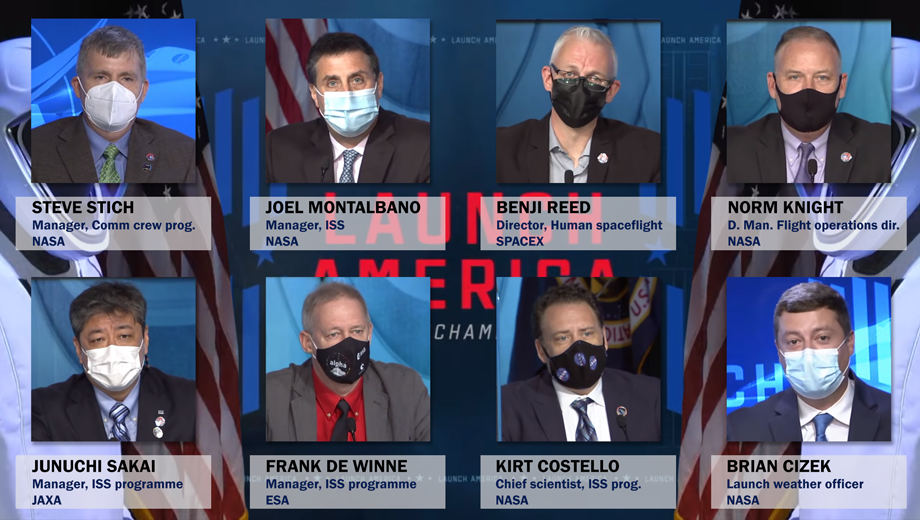 NASA’s pre-launch conference panel of experts. NASA, 20 April 2021.
NASA’s pre-launch conference panel of experts. NASA, 20 April 2021.
Reduce, Reuse and Recycle
Following SpaceX’s motto “Reduce, Reuse and Recycle”, the main components of the rocket were reused after being flight-certified by previous missions:
- The Dragon Capsule that accommodated the crew flew astronauts Bob Behnken and Dough Hurley in the successful Demo-2 test flight that returned from ISS on 20 August 2019.
- The first stage of the Falcon-9 rocket was used to launch Crew-1 to ISS on 16 November 2020.
Reusability is key to the programme. It is based on proven functionality, reliability and cost-efficiency in accessing space. Benji Reed, Director of Human Flight Operations at SpaceX revealed that the Dragon vehicles can be certified for reuse at least five times although some components may need replacement depending on results of testing. Falcon rockets were expected to qualify for 10 flights for instruments while certification for human transport will be discussed after this second flight.
The first stage of a Falcon 9 rocket can be recovered and reused in various missions, saving nearly US $35million or 70% of the cost of a rocket.
The following video shows SpaceX Falcon 9 rocket’s launch and landing from 21 December 2015. The mission delivered 11 satellites to low-Earth orbit and it’s first stage landed back on the launchpad. An emotional success for the Space-X team that advanced rocket technology upon knowledge acquired though the history of rocket development.
Elon Musk, founder, Chief Executive Officer (CEO), Chief Technical Officer (CTO) and Chief Designer of SpaceX, explains the significance of landing a rocket’s boost stage or first stage and why it lands on a drone ship parked in the middle of the Atlantic.
Busy April 2021 for ISS
Recent activity at ISS included:
- 05 April: First ever port relocation of a commercial aircraft. The four astronauts of Crew-1 undocked their SpaceX Crew Dragon "Resilience" from the ISS' Harmony “forward port” (facing the direction of ISS’s flight) and manoeuvred their vehicle to redock at Harmony's “zenith port” (facing space) in an operation that took 38minutes. The astronauts were required to suit-up in case of issues while re-docking and the need to return to Earth.
- 09 April: Arrival of Expedition 64 that launched that day onboard a Soyouz MS-18 rocket. The spacecraft carried NASA astronaut Mark Vande Hei and Roscosmos cosmonauts Oleg Novitsky and Pyotr Dubrov, taking 3 hours to travel 2 orbits before docking. The crew will work at ISS for 6 months.
- 16 April: Departure of Soyuz MS-17 spacecraft that landed on Earth that day bringing back NASA Astronaut Kate Rubins and cosmonauts Sergey Ryzhikov and Sergey Kud-Sverchkov of the Russian space agency Roscosmos.
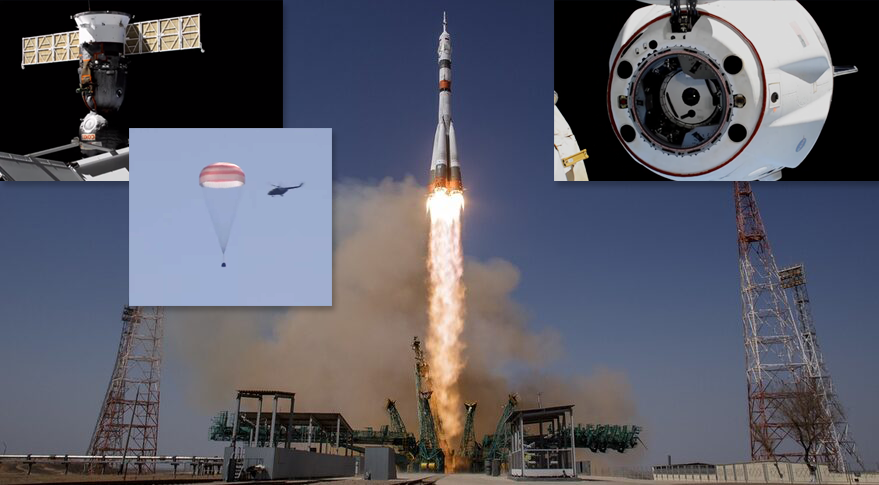 Left: Return of Soyuz MS-17 on 16 April. Centre: Launch of Soyouz MS-18 on 09 April. Right: Port relocation of Dragon Resilience on 05 April. NASA/JPL, 2021.
Left: Return of Soyuz MS-17 on 16 April. Centre: Launch of Soyouz MS-18 on 09 April. Right: Port relocation of Dragon Resilience on 05 April. NASA/JPL, 2021.
With the arrival of Crew-2, the ISS had 11 people onboard until 01 May, when Crew-1 returned to Earth marking the first successful mission that transported crew to and back from ISS using a commercial vehicle.
The crew
The Crew-2 flight will carry Expedition 65/66, composed by NASA astronauts Shane Kimbrough and Megan McArthur (spacecraft commander and pilot, respectively) along with Japan Aerospace Exploration Agency (JAXA) astronaut Akihiko Hoshide and European Space Agency (ESA) astronaut Thomas Pesquet, who will serve as mission specialists to the space station. This is the first time that astronauts from the three space agencies travel together in at least 20 years.
Astronaut Megan McArthur. NASA, 2021.
Pilot Dr Megan McArthur is an aerospace engineer with a PhD in Oceanography who trained as an astronaut in 2000, she most notably flew the Space Shuttle with Mission STS-125 in 2009 to repair the Hubble Telescope. An arduous job that took 11 days of sequential EVAs. Her husband, Astronaut Bob Behnken flew the same Dragon vehicle in 2020 as part of Demo-2 mission.
Astronaut Shane Kimbrough. NASA, 2021.
Commander Col Shane Kimbrough is an aerospace engineer, retired US Army colonel and Apache helicopter pilot, a veteran of Operation Desert Storm in 1991 and NASA astronaut trainer until his selection to train as astronaut. He flew the Space Shuttle with Mission STS-126 in 2008 and Expedition 49/50 to ISS in 2017. He performed various Extravehicular Activities (EVAs) in both missions.
Astronaut Akihiko Hoshide. NASA, 2021.
Flight Engineer Akihiko Hoshide is a mechanical engineer with an MSc in Aerospace Engineering. He was a support engineer to training astronauts before his selection to being trained in 1999. He flew the Space Shuttle with Mission STS-124 in 2008 and was part of Expedition 32/33 to ISS in 2012 returning after 127 days in space.
Astronaut Thomas Pesquet. NASA, 2021.
Mission Specialist Thomas Pesquet is an aerospace engineer with a Masters in Space Systems and Space Vehicle Mechanics and an airline transport and commercial pilot. He trained as an European Space Agency astronaut in 2009 and was part of Expedition 50/51 to ISS in 2016, during which he performed two EVAs with Shane Kimbrough and returned to Earth in 2017 after 196 days in space.
Pesquet is the first European astronaut onboard a SpaceX flight and Hoshide is the second Japanese astronaut onboard this type of spacecraft. This crew will stay at ISS for 6 months and perform 260 experiments including a French-sponsored Grip-Grasp experiment commissioned and installed by Pesquet on his first flight in 2016.
During their time at ISS, the crew will welcome the arrival of the European Robotic Arm that will fly to ISS on 15 July 2021 attached to the Roscosmos’ Multipurpose Laboratory Module (MLM), also known as Nauka (Russian for Science), that will launch onboard a Russian Proton rocket from Baikonur Cosmodrome in southern Kazakhstan. The Roscosmos State Corporation for Space Activities (Roscosmos) agreed to carry the European Robotic Arm for ESA in 2005, a commission in which Pasquet was involved. The MLM module was scheduled to launch in 2007 but was cancelled for technical issues, since then, the mission was postponed repeatedly. Fourteen years later, Roscosmos will finally deliver on their contract with ESA. Once installed on ISS, the robotic arm will be used exclusively by the Russian segment for transport and relocation of future loads.
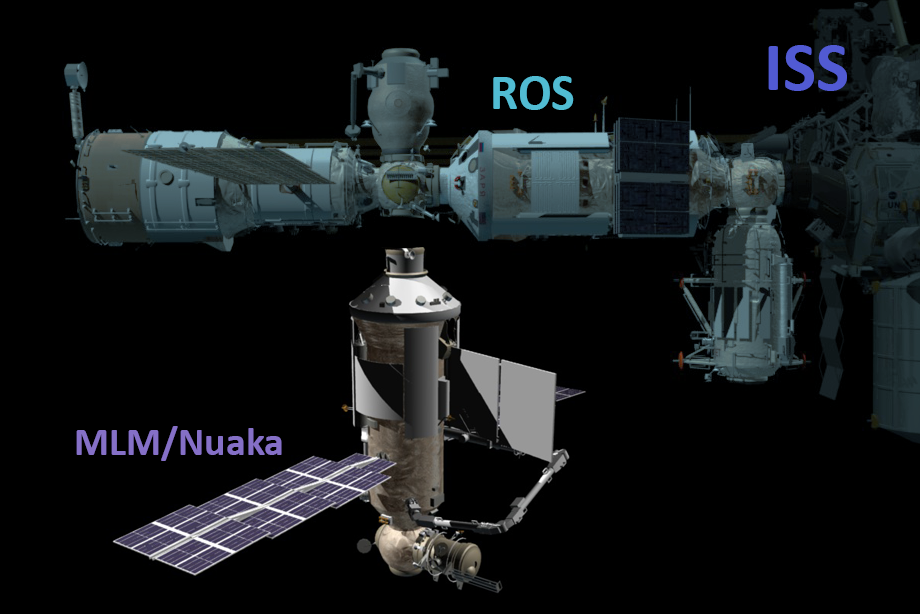 3D model of the MLM or Nuaka module approaching the Russian Orbital Segment (ROS), an extension of the International Space Station (ISS). NASA 2021.
3D model of the MLM or Nuaka module approaching the Russian Orbital Segment (ROS), an extension of the International Space Station (ISS). NASA 2021.
Science research
Highlights of the experiments flying with Crew-2 onboard Dragon Endeavour:
- Celestial Immunity and the capability to fly Donor Peripheral Blood Mononuclear Cells end elicit in them new potential pathways for immunity (by the pharmaceutical company Sanofi Pasteur).
- The CHIME experiment for characterising Human Immunodeficiency in microgravity and will be flying tissue chips with THP-1 cell line, a Leukaemia cell line, in which they will look for changes in immune response to microgravity.
- STEM education: Story time in space, which consists of 8 demonstration packages, a heat-transfer demo experiment that works along the demonstration of reading in space. This will be part of the celebration of the Australian literacy day on 19 May.
Launch day
Friday 23 April 2021
Crew suit-up and walk out
Four hours before launch the astronauts were in the Suit-Up Room of the Neil Armstrong Operations and Checkout Building (O&C), where they changed into their space suits, helped by suit technicians who verified their suit integrity. Astronaut suits are custom made to ensure anatomical fit for each astronaut. Their gloves and boots are manufactured to their specific size and their helmets are printed to match the shape of their heads.
The umbilical cord that carries communications, power and cool air distributed in the suit was tested while the astronauts lied on chairs that replicated the position of their own in the Dragon capsule.
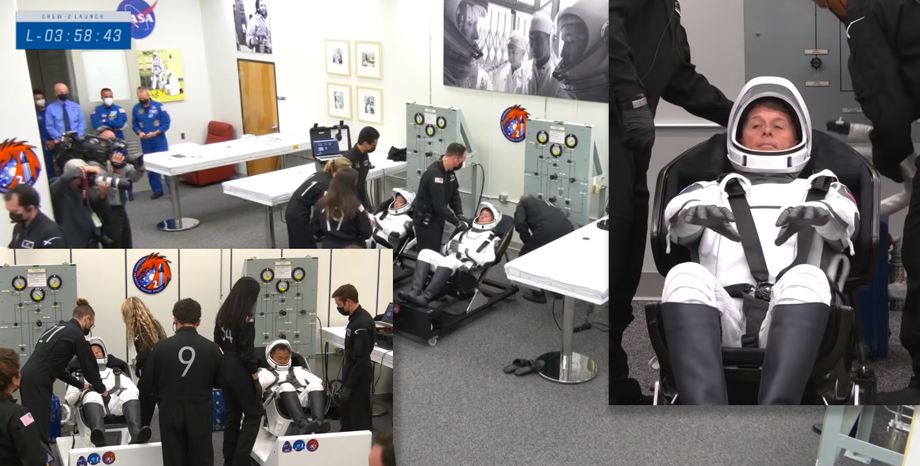 Astronaut Suit-Up Room: Four hours before launch the crew put on their journey suits. NASA, 23 April 2021.
Astronaut Suit-Up Room: Four hours before launch the crew put on their journey suits. NASA, 23 April 2021.
The "Crew walk out" took place 3hr before launch and was their opportunity for final good-byes with co-workers and families before riding the Tesla electric car convoy that led them to launch pad 39A, the same pad used by the Apollo and Shuttle missions.
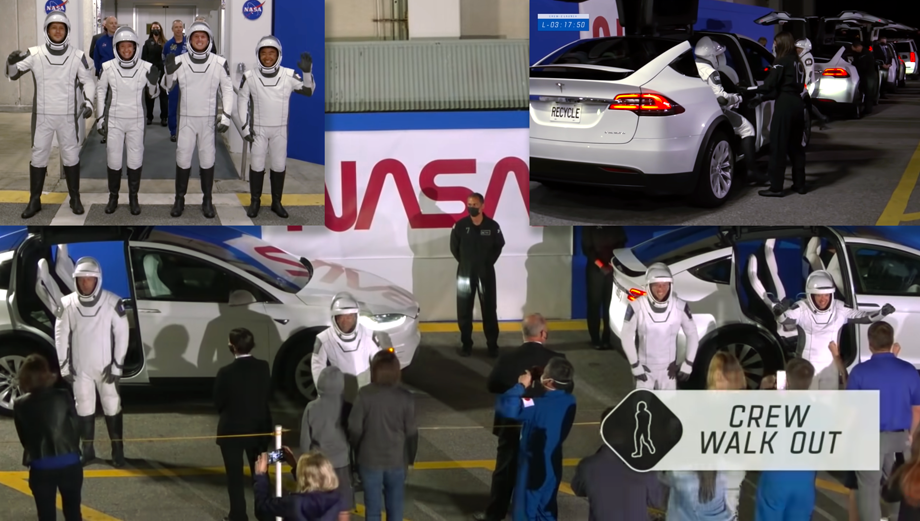 Crew walk out: Three hours before launch the crew says their farewell to their families and board their transport to the launchpad. NASA, 23 April 2021.
Crew walk out: Three hours before launch the crew says their farewell to their families and board their transport to the launchpad. NASA, 23 April 2021.
The licence plates on the last three cars of the convoy displayed a word each, Reduce, Reuse and Recycle.
At the launchpad the crew ascended 80 m on the Fixed Service Structure to reach the Crew Access Arm and then the White Room before they were helped into their seats onboard Dragon Endeavour (Crew Ingress phase). After communication, suits, seats, and interfaces were checked for the last time, the side hatch of the capsule was meticulously closed.
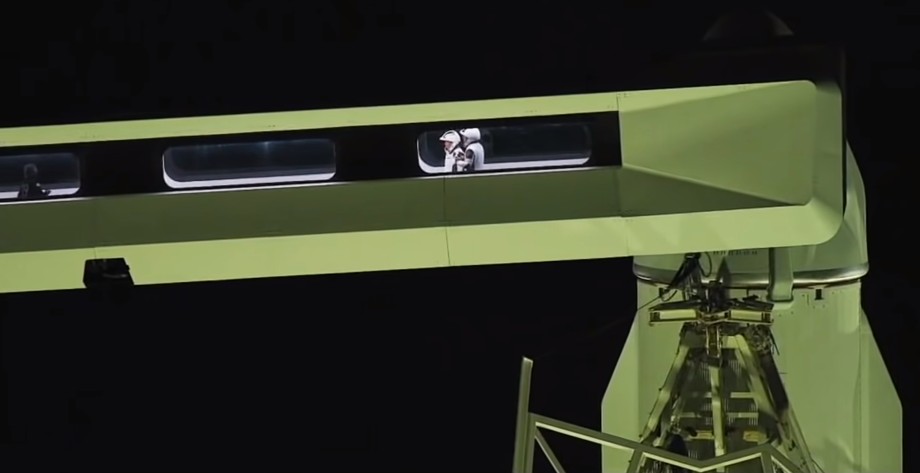 Astronauts looking back as they walk along the Crew Access Arm at Lauch pad 39-A. NASA, 23 April 2021.
Astronauts looking back as they walk along the Crew Access Arm at Lauch pad 39-A. NASA, 23 April 2021.
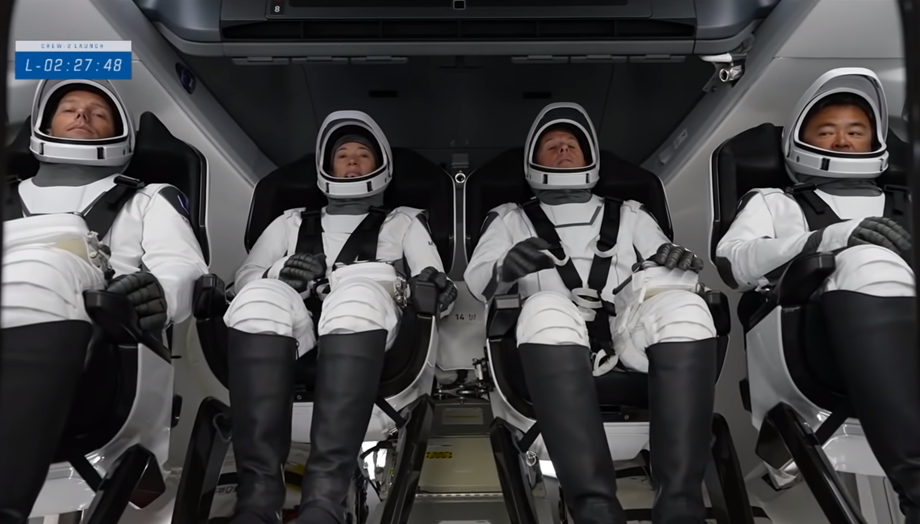 SpaceX Crew-2, sat on their seats onboard Dragon Endeavour. Prepared for launch. NASA, 23 April 2021.
SpaceX Crew-2, sat on their seats onboard Dragon Endeavour. Prepared for launch. NASA, 23 April 2021.
 SpaceX Crew-2, celebratory handshakes. Ready to go. NASA, 23 April 2021.
SpaceX Crew-2, celebratory handshakes. Ready to go. NASA, 23 April 2021.
Starting at 35 minutes before launch, propellant was loaded onto the Falcon 9 rocket, until the last 5 minutes when the Terminal Count was initiated and the Dragon’s onboard computers took control of the spacecraft.
Launch
Every system was verified and approved for launch at Launch Complex 39A before control was transferred to Crew-2 to launch at 5:49 hr.
The tranquillity of the morning of Friday 23 April 2021 was abruptly broken by the majestic roar of the rocket engines, followed by applause and cheers from all teams at Kennedy Space Centre. The jubilation was mirrored around the world as the four astronauts from 3 countries began their journey to ISS. That was the culmination of the groundwork and the beginning of the mission’s flight mode.
The 9 Merlin engines propelling the first stage of the Falcon 9 rocket provided 770 tonnes of thrust to lift the 550 tonnes weight of the vehicle.
 Lift-off of Falcon 9 carrying SpaceX Crew-2 to ISS. NASA, 10:49 UK (05:49 EST) on Friday 23 April 2021.
Lift-off of Falcon 9 carrying SpaceX Crew-2 to ISS. NASA, 10:49 UK (05:49 EST) on Friday 23 April 2021.
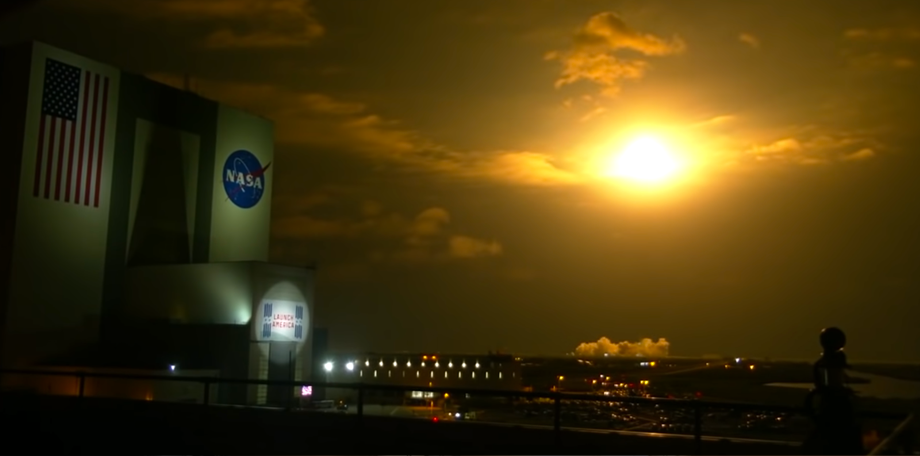 The Falcon 9 rocket plunges into the skies after launch from Kennedy Space Centre in Florida, USA. NASA, 23 April 2021.
The Falcon 9 rocket plunges into the skies after launch from Kennedy Space Centre in Florida, USA. NASA, 23 April 2021.
Ascent
Ascent velocities increased rapidly. One minute into the flight, the Falcon 9 was travelling at a velocity of 1,036 km/h before going supersonic at a velocity of Mach 1 and an altitude of 8.8 km. The speed continued to increase passing 1,270 km/h to reach Max-Q or Maximum Dynamic Pressure, the maximum structural load expected during ascent. Even faster, at 3,300 km/h and 35 km of altitude Falcon 9 passed the MVAC Engine Chill point when the Second stage single engine was started. At 2 min 30 sec into the flight, a speed of 5,700 km/h and an altitude of 64 km the 9 Merlin engines were throttled-down, and at 6,800 km/h and 78.9km altitude, they were shut-down.
At a velocity of 6,930 km/h and altitude of 87km, the stages separated, and the second stage engine ignited.
 Top: The 9 Merlin engines at full throttle as the first stage propelled the vehicle. Stages: View from inside the top of the first stage or booster (left) and the engine compartment of the second stage (right): The Second Stage engine started and then ignited as the stages separated. NASA, 23 April 2021.
Top: The 9 Merlin engines at full throttle as the first stage propelled the vehicle. Stages: View from inside the top of the first stage or booster (left) and the engine compartment of the second stage (right): The Second Stage engine started and then ignited as the stages separated. NASA, 23 April 2021.
Booster's landing
While the second stage kept ascending past the 110 km of altitude, the unpowered first stage continued a curved falling trajectory towards the Atlantic Ocean. The Grid Fins near the bottom of the vehicle opened at 3min into flight, controlling its trajectory with the help of side thrusters.
By the time the Dragon capsule crossed the 197 km of altitude, ascending at a velocity of 17,800 km/h, the first stage kept falling, and when it reached an altitude of 35km, it ignited 3 of its engines to slow down for atmosphere re-entry. At 9 minutes into flight, the first stage started its Landing Burn using a single engine for a final approach towards the Autonomous Spaceport Drone Ship (ASDS) named “Of course I still love you”, stationed off the coast of Florida.
The arrival of the first stage induced a strong vibration on the drone ship that caused a temporary misalignment of the satellite connection, resulting in a loss of video signal. When communications were restored, the first stage had landed safely.
 From the top (1st stage left/2nd stage right): The first stage opened its grid flaps for a controlled flight. Ignition of 3 engines to enter the atmosphere. Landing burn failed to broadcast. First stage standing on drone ship. Second stage switched off its engine as it reached orbit. NASA, 23 April 2021.
From the top (1st stage left/2nd stage right): The first stage opened its grid flaps for a controlled flight. Ignition of 3 engines to enter the atmosphere. Landing burn failed to broadcast. First stage standing on drone ship. Second stage switched off its engine as it reached orbit. NASA, 23 April 2021.
Examples of previous Falcon 9 first stage landings on a drone ship stationed in the Atlantic Ocean.
The following is a 360-degree view video of the landing of a first stage on a drone ship over the ocean.
Drag the video frame as the video plays to see the first stage approaching against the blue sky, and land in a smoothly choreographed autonomous operation.
The SpaceX drone-ship “Of course I still love you” entered service in 2015. In the picture below, three barges are towing the drone-ship and its cargo, a Falcon 9 booster or first-stage, for mooring (berthing or parking) at Port Canaveral in Florida.
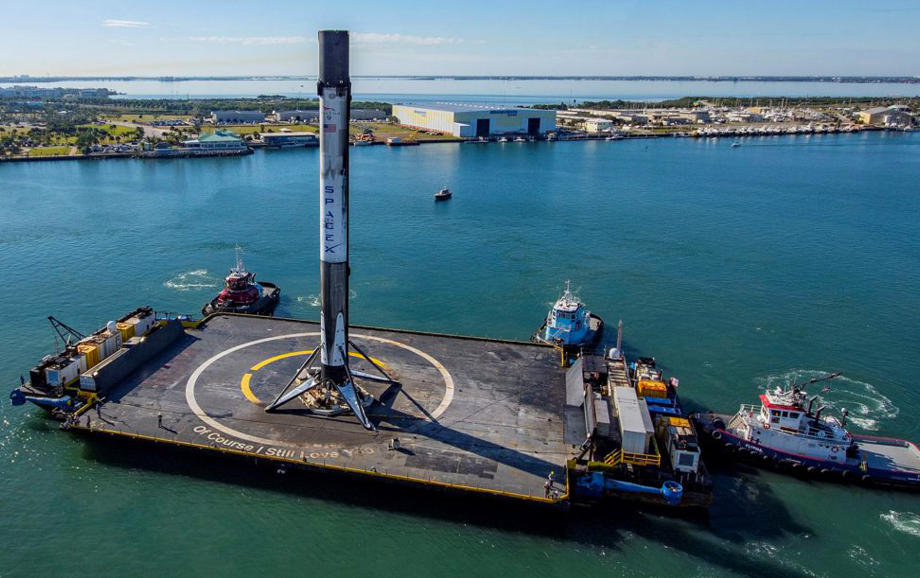 The Autonomous Spaceport Drone Ship (ASDS) named “Of course I still love you” carrying a Falcon 9 booster. Spacexfleet.com, 2020.
The Autonomous Spaceport Drone Ship (ASDS) named “Of course I still love you” carrying a Falcon 9 booster. Spacexfleet.com, 2020.
Flight stages
The main stages followed by the mission to reach orbit can be summarised as follows:
- Falcon 9 rocket launch.
- Ascent.
- The first stage booster separates from the second stage of the rocket and the Dragon capsule, which continue their journey into orbit. Up to this point the engines were propelling the rocket from the back end of the vehicle to lift it vertically and then obliquely to gain speed and enter orbit trying to escape Earth’s gravitational pull.
- The first stage flips over to have her engines point in the direction of travel and performs a boost back burn to slow down and begin to fall back to Earth.
- The grid fins are deployed to control the trajectory and an entry burn limits the speed of fall.
- Aerodynamic guidance assisted by side jets steer the first stage towards the drone ship waiting in the Atlantic Ocean.
- The first stage performs an autonomous vertical landing on the drone ship.
 Diagram of the trajectory and stages as the Dragon capsule is delivered into orbit and the first stage of the Falcon 9 rocket returns to Earth and lands vertically. Teslarati, 2020.
Diagram of the trajectory and stages as the Dragon capsule is delivered into orbit and the first stage of the Falcon 9 rocket returns to Earth and lands vertically. Teslarati, 2020.
In orbit
The Dragon capsule mounted on the second stage reached a maximum velocity of 27,000 km/h at an altitude of 197 km before shutting down its single engine and reaching Orbital Insertion. The Graphic shows the trajectories of the first and second stages at 10 minutes after launch.
At an altitude of 200 km above sea level, the vehicle reached a horizontal velocity of 27,000 km/h, which produced a centrifugal force that equalled the gravitational pull of Earth. As both opposing forces were balanced the crew began to experience zero gravity (0-G) or micro-gravity and the 0-G indicator, traditionally a soft toy, began to float. The crew’s children named the toy “Guin-Guin”, a fitting name for a penguin.
 From top: Trajectory of stage 1 and stage 2 at 10 minutes. Separation of the 2nd stage from Dragon. Guin-Guin, the 0-G indicator, floating in the cabin. NASA, 23 April 2021.
From top: Trajectory of stage 1 and stage 2 at 10 minutes. Separation of the 2nd stage from Dragon. Guin-Guin, the 0-G indicator, floating in the cabin. NASA, 23 April 2021.
Approaching ISS
The second stage of the Falcon 9 rocket separated from the Dragon Endeavour capsule carrying SpaceX Crew-2 once this was delivered into orbit. The capsule’s 16 Draco thrusters outfitted around her outer shell helped adjust her trajectory while in orbit, circling around the planet to gain speed and altitude, chasing the ISS until they matched. Three main burns were required:
- Phase burn to insert Dragon into the correct orbit.
- Boost burn to increase the altitude and get closer to ISS.
- Close coelliptic burn to make the orbit more elliptical and match that of ISS, getting within 10 km from the station.
The final approach required smaller burns to slowly approach the station past the 7 km radius.
 Approach to ISS: After Lift Off and Orbit Activation, there were 2 Phasing Burns to accelerate to leave orbit and catch up with ISS on a Final Coelliptic orbit. This was followed by a Proximity Operation and Docking. NASA, 23 April 2021.
Approach to ISS: After Lift Off and Orbit Activation, there were 2 Phasing Burns to accelerate to leave orbit and catch up with ISS on a Final Coelliptic orbit. This was followed by a Proximity Operation and Docking. NASA, 23 April 2021.
At 220 m from ISS, the Dragon Endeavour capsule entered Waypoint 1 and slowly approached towards Waypoint 2. This process took several minutes and was carried out autonomously.
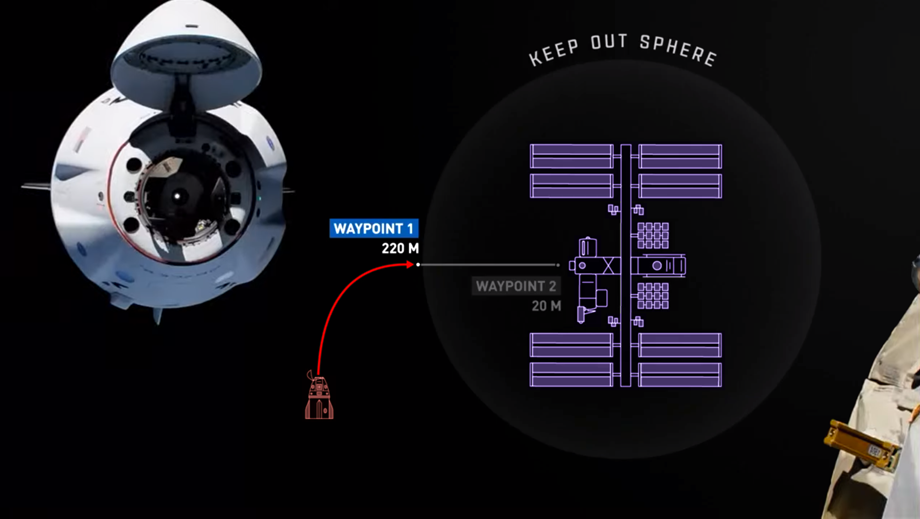 Superimposed diagram showing the Dragon Endeavour capsule final approach to the ISS and the distances of Waypoint 1, 2 and the Keep Out Sphere. NASA, 24 April 2021.
Superimposed diagram showing the Dragon Endeavour capsule final approach to the ISS and the distances of Waypoint 1, 2 and the Keep Out Sphere. NASA, 24 April 2021.
As the capsule slowly approached to the Forward-Facing Docking port of ISS, the entire station was on view, with the Dragon Resilience capsule parked on the Zenith port. Both ports are located on the US-built Node 2 of the station.
 View of the entire ISS from Dragon Endeavour as it approached the station. Dragon Resilience is visible attached to the Zenith port, above the empty front-facing port awaiting the new arrival. NASA, 24 April 2021.
View of the entire ISS from Dragon Endeavour as it approached the station. Dragon Resilience is visible attached to the Zenith port, above the empty front-facing port awaiting the new arrival. NASA, 24 April 2021.
After approval from the ground crew, who verified every step, the Dragon capsule proceeded to slowly approach the ISS reaching Waypoint 2, 20m from the station.
 Photograph of Dragon Endeavour at Waypoint 2, 20 metres from ISS. NASA, 24 April 2021.
Photograph of Dragon Endeavour at Waypoint 2, 20 metres from ISS. NASA, 24 April 2021.
At 3 metres from ISS the capsule prepares for a 2-phase docking: A soft capture where the vehicles align ports and a hard capture, in which 12 hooks physically secure the spaceships together.
The image below shows some of the rectangular slots near the edge of the silver ring that surrounds the coupling device where the hooks from the forward-facing docking will fit to make a secure connection.
 Photograph of Dragon Endeavour at 3 m from docking to ISS. NASA, 24 April 2021.
Photograph of Dragon Endeavour at 3 m from docking to ISS. NASA, 24 April 2021.
The final approach to the station took place at an altitude of 423 km over the South Indian Ocean, as both vehicles were travelling in tandem at a speed of 28,163 km/h.
Capsule capture
Soft capture of the Dragon Endeavour capsule was confirmed at 02:08 hr Pacific US time (09:08 GMT) on 24th April 2021. Hard capture followed successfully, and the four astronauts were welcomed by ISS commander Shannon Walker.
The astronauts were given a go-ahead to take off their space suits while waiting for re-pressurisation. This process takes 2 hours and aims at checking the seals for hermiticity and pressurising the vestibule that separates the hatch of the capsule (Dragon hatch) from that of the station (Androgynous Peripheral Assembly System [APAS] hatch). This short corridor is at vacuum and needs to be pressurised and heated to match the environment of both vehicles before the hatches are opened.
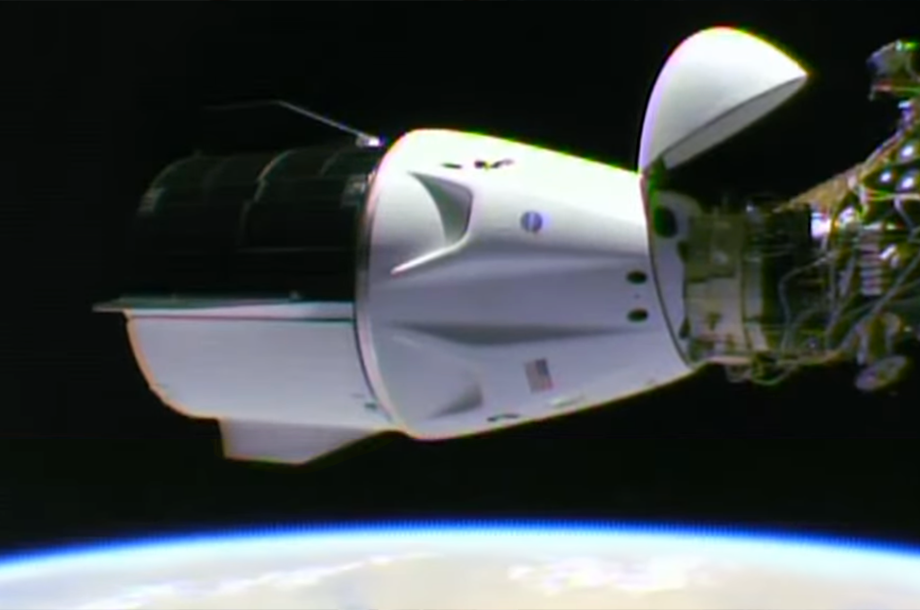 Soft capture of Dragon Endeavour capsule in preparation for hatch opening. NASA, 24 April 2021.
Soft capture of Dragon Endeavour capsule in preparation for hatch opening. NASA, 24 April 2021.
The Dragon hatch was opened at 11:05 hr, and after more verifications, the 4 crew from the capsule joined the 7 crew onboard the the space station.
 The Dragon hatch opened allowing flight engineer Victor Glover greet his expedition colleagues passing through the vestibule. NASA, 24 April 2021.
The Dragon hatch opened allowing flight engineer Victor Glover greet his expedition colleagues passing through the vestibule. NASA, 24 April 2021.
The first Crew-2 astronaut to emerge from the hatch was Akihiko Hoshide, preceded by Guin-Guin, the zero-gravity marker and mascot of the flight. Hoshide replaced Shannon Walker (Expedition 64/65) as Commander of ISS. Walker returned to earth on 1st May 2021 after completing 168 days in orbit.
Following naval tradition, the arrival of the new crew members was announced by ringing a ship's bell (the naval etiquette of requesting and granting permission for entry is no longer used).
 The first Crew-2 member emerging from the Dragon Endeavour capsule was the now commander Akihiko Hoshide, preceded by Guin-Guin, the toy-penguin and zero-gravity indicator and mascot of Crew-2. NASA, 24 April 2021.
The first Crew-2 member emerging from the Dragon Endeavour capsule was the now commander Akihiko Hoshide, preceded by Guin-Guin, the toy-penguin and zero-gravity indicator and mascot of Crew-2. NASA, 24 April 2021.
The astronauts celebrated their successful meeting at ISS with happy embraces and handshakes in microgravity.
 Crew-2 arrival at the ISS. Embraces all around. Megan McArthur greeted by Siochi Noguchi. NASA, 24 April 2021.
Crew-2 arrival at the ISS. Embraces all around. Megan McArthur greeted by Siochi Noguchi. NASA, 24 April 2021.
NASA administrator Steve Jurczyk, associate administrator Cathy Leaders, JAXA president Dr Yamakawa Hiroshi, and ESA director general Dr Josef Aschbacher congratulated Crew-2 for their successful flight and arrival, and commented on the various “firsts” events of the mission, including:
- First handover of commercial crews at the ISS.
- The first time there are two Dragon capsules, Resilience and Endeavour, docked to ISS.
- First reuse of a capsule.
- First reuse of a booster by both missions.
- The first time in 20 years since NASA, ESA and Roscosmos astronauts were together at ISS.
- The first time the crew will host commercial customers at ISS, including a movie star and a director.
- The first time a feature movie will be filmed at ISS by a civilian crew.
The crew acknowledged the tremendous achievement of the commercial partner Space-X for taking flight technology to this level.
 SpaceX Crew 1 and 2 completing Expedition 65 and members of Expedition 64 pose for a group photo.
SpaceX Crew 1 and 2 completing Expedition 65 and members of Expedition 64 pose for a group photo.Left to Right, Top-back: Mark Vande Hei, Oleg Novitsky, Pyotr Dubrov;
Bottom-front: Mike Hopkins, Soichi Noguchi, Akihiko Hoshide, Shane Kimbrough, Thomas Pasquet, Megan McArthur, Shannon Walker and Victor Glover. NASA, 24 April 2021.
Watch the full broadcast of Dragon Endeavour’s final approach and docking, and the opening hatch ceremony at ISS (3hr 23min).
Coming up at ISS
Continuing with the new enterprise to promote civilian commercial visits to the ISS the next visitors to the station will come from Japan in December 2021, followed by the Axium mission in January 2022.
Crews are being trained all over the world to ensure they are prepared to handle safety issues and do some science during their week-long visits to ISS.
Live broadcast
The successfully delivering Crew-2 into orbit marked the accomplishment of one of the main goals of NASA’s Commercial Crew Programme and their commercial partner SpaceX. All the ground teams celebrated the event joined by an audience of millions throughout the world, thanks to the live broadcast of the launch via NASA and SpaceX’s channels.
The event was broadcast from Kennedy Space Centre in Florida (launch site), SpaceX headquarters in Hawthorne, California, and NASA’s control centre at Johnson Space Centre in Huston, Texas.
 NASA-Live broadcast team: Top from Florida: NASA Astronaut Tracy Caldwell Dyson; Kate Tice, SpaceX Senior certification engineer; Marie Lewis, NASA communications.
NASA-Live broadcast team: Top from Florida: NASA Astronaut Tracy Caldwell Dyson; Kate Tice, SpaceX Senior certification engineer; Marie Lewis, NASA communications.Bottom from California: Jessie Anderson, SpaceX engineer; Gary Jordan, NASA communications. From Texas: Courtney Beasley, NASA public affairs. NASA, 23 April 2021.
Watch the broadcast of Space-X Crew 2 launch to the International Space Station on 23 April 2021 (4hr 45min).
REFERENCES
2. » NASA (2020) NASA’s SpaceX Crew-1 Astronauts Headed to International Space Station (16 November 2020) [Online article]. Available here. (Accessed: 21 Apr 2021).
3. » NASA (2021) Port Relocation of SpaceX Crew Dragon on the International Space Station (05 April 2021) [Online video]. Available here. (Accessed: 21 Apr 2021).
4. » NASA (2021) Expedition 63 Launch to the International Space Station (09 April 2021) [Online video]. Available here. (Accessed: 21 Apr 2021).
5. » NASA (2021) Three Space Station Crew Members Return Home Aboard Soyuz Spacecraft (17 April 2021) [Online video]. Available here. (Accessed: 21 Apr 2021).
6. » NASA (2021) NASA Updates Launch Date, TV Coverage for Agency’s SpaceX Crew-2 Mission (21 April 2021) [Online article]. Available here. (Accessed: 21 Apr 2021).
7. » Wikipedia (2021) Baikonur Cosmodrome [Online article]. Available here. (Accessed: 22 Apr 2021).
8. » Wikipedia (2021) Nauka (ISS module) [Online article]. Available here. (Accessed: 22 Apr 2021).
9. » Foust J (2021) Soyuz launches new crew to International Space Station (09 April 2021) [Online article]. Available here. (Accessed: 06 May 2021).
10. » Wikipedia (2021) Roscosmos [Online article]. Available here. (Accessed: 22 Apr 2021).
11. » NASA (2021) NASA Live: Official Stream of NASA TV's Media Channel (23 April 2021) [Online video]. Available here. (Accessed: 23 Apr 2021).
12. » NASA (2021) Elon Musk Discusses Starship & Successful Crew-2 Launch (23 April 2021) [Online video]. Available here. (Accessed: 23 Apr 2021).
13. » NASA (2021) NASA's SpaceX Crew-2 Mission Arrive at the International Space Station (24 April 2021) [Online video]. Available here. (Accessed: 24 Apr 2021).
14. » NASA (2021) Space to Ground: A Crew of Ten: 04/09/2021 (09 April 2021) [Online video]. Available here. (Accessed: 06 May 2021).
10. » Wikipedia (2021) K. Megan McArthur [Online article]. Available here. (Accessed: 07 May 2021).
15. » Wikipedia (2021) Shane Kimbrough [Online article]. Available here. (Accessed: 07 May 2021).
16. » Wikipedia (2021) Akihiko Hoshide [Online article]. Available here. (Accessed: 07 May 2021).
17. » Wikipedia (2021) Thomas Pesquet [Online article]. Available here. (Accessed: 07 May 2021).
18. » Spacexfleet (2021) Of Course I Still Love You [Online article]. Available here. (Accessed: 13 May 2021).
19. » Primal Space (2018) Why does the SpaceX drone ship camera cut out? [Online video]. Available here. (Accessed: 13 May 2021).
20. » SpaceX (2016) Three Camera Angles | Falcon 9 First Stage Landing on Droneship [Online video]. Available here. (Accessed: 13 May 2021).
21. » Groh J (2021) SpaceX Crew Dragon astronauts are chasing the space station around Earth [Online article]. Available here. (Accessed: 30 May 2021).
23. » Wikipedia (2021) Expedition 65 [Online article]. Available here. (Accessed: 03 Sep 2021).
24. » Moran N (2021) Spacewalkers complete second roll out solar array installation. NASA, 25 June 2021 [Online article]. Available here. (Accessed: 26 Sep 2021).
25. » NASA (2021) New solar arrays to power NASA’s International Space Station research. 11 January 2021. [Online article]. Available here. (Accessed: 26 Sep 2021).
26. » Leary W (2000) Space station crew greets first visitors. 09 December 2000. [Online article]. Available here. (Accessed: 01 Oct 2021).
27. » Wikipedia (2021) Yulia Peresild. [Online article]. Available here. (Accessed: 05 Oct 2021).
28. » Macnab G (2021) Battle for Sevastopol sets major Russian release. ScreenDaily.com, 10 Feb. 2015. [Online article]. Available here. (Accessed: 05 Oct 2021).
29. » Wikipedia (2021) The Challenge (2022 film). [Online article]. Available here. (Accessed: 05 Oct 2021).
30. » Wikipedia (2021) Progress MS-17. [Online article]. Available here. (Accessed: 05 Oct 2021).
31. » Space Sleuthing (2021) Russian movie in space, part 7, 25 May 2021. [Online article]. Available here. (Accessed: 05 Oct 2021).
== END of article: Expedition 65 & SpaceX Crew-2: Journey to ISS – April to October 2021 ==
No comments:
Post a Comment